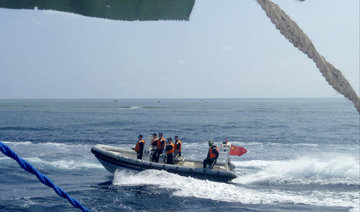CROTONE, Italy: Survivors and family members of victims of a tragic shipwreck a year ago that killed 94 migrants, including 35 minors, just a few meters off Italy’s southern coast, returned for three days of commemorations ending Monday, calling for truth and justice.
A torchlight vigil on the beach where the ship was wrecked, a photo exhibition and a protest march were among events organized by a group of activists named Network Feb. 26 — after the date of the tragedy — around the town of Crotone. Most of the dead came from countries in the Middle East or South Asia.
“One year after the carnage, their right to the truth, to justice and to be reunited with their families has not been guaranteed yet,” the group wrote on its Facebook page.
On Feb. 26 last year, a wooden boat departed from Turkiye carrying about 200 migrants and sank just a few meters (yards) off the coast of southern Calabria while trying to land on the seaside resort beach of Steccato di Cutro.
Network Feb. 26 includes over 400 associations that have repeatedly asked the Italian government to seek the truth about one of the deadliest migrant shipwrecks in the Mediterranean.
The group has denounced repeated policy failures and alleged violations of human rights by Italian and EU authorities, seen as the main cause behind the long string of deaths of migrants who face risky trips to reach European coasts in their search for a better life.
Activists have also complained that some of the relatives and survivors were denied the right to return to Crotone for the anniversary of the shipwreck, due to difficulties in obtaining proper documents.
“When we met (Italian Premier Giorgia Meloni ) in Rome after the tragedy, (she) promised that her staff would (work) to reunite us and our families, but that has never happened,” said Haroon Mohammadi, 24, a survivor from Herat, Afghanistan, who lost some of his friends in the shipwreck.
Mohammadi now lives in Hamburg, Germany, where he has obtained a one-year residence permit, and hopes to continue to study economics at a university there.
“It’s very difficult for me to be back here, but I came to honor friends and relatives we’ve lost. We became like a family following that day,” he said.
Many of the dead and survivors had fled Afghanistan, Iran, Pakistan and Syria, hoping to join family members in Italy and other Western European countries.
After the shipwreck, the right-wing government of Meloni approved a decree establishing a new crime — people smuggling that causes the death of migrants — punishable by up to 30 years in prison, and pledged to further toughen its battle against illegal immigration.
On Sunday, hundreds of people, including a group of about 50 survivors and relatives of the victims, marched in Crotone despite heavy rain with a banner asking to “stop deaths at sea.” Demonstrators also stopped to pay homage in front of PalaMilone, a sports complex that hosted the victims’ caskets.
On Saturday, Crotone’s Pitagora Museum inaugurated a photo exhibit titled “Dreams Cross the Sea,” featuring 94 photographs, one for each of the victims.
In the early hours of Feb. 26, the boat named Summer Love sank just a few meters (yards) from the coast of the southern Calabria region, while trying to land on the nearby beach. Authorities say the shipwreck resulted in the deaths of at least 94 of the 200 on board. Eighty passengers survived and about 10 were considered missing. Dozens of young children were onboard and almost none survived.
The shocking accident raised several questions over how EU border agency Frontex and the Italian coast guard responded to it.
Six days after the tragedy, Meloni told journalists that “no emergency communication from Frontex reached Italian authorities,” who she said were not warned that the vessel was in danger of sinking.
However, a Frontex incident report later indicated that Italian authorities told the EU agency at the time of the sighting that the case was not considered an emergency.


























